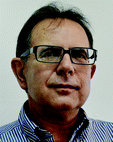DOI: 10.1039/C3CC90015K
(Profile)
Chem. Commun., 2013, 49, 3923-3924
Interview with Avelino Corma
| ||||||
Do you remember what it felt like to publish your first ChemComm article?
The first ChemComm article I published (“Determination of crystallographic planes on the surface of supported metallic crystallites”. J. Chem. Soc., Chem. Commun., 1983, 1512) was when starting as an independent researcher in Spain after my postdoc in Canada. At that time I had just a table and a chair with no possibility to do experiments. Then I took one already published PhD from the library of the institute and the corresponding publications on Pd nanoparticles on different supports, in which a deep characterization of the metal particles by the adsorption of Co, H2 and O2 was done. I made a reinterpretation of the data and showed that it was possible to determine the population of the crystals with (111), (110) and (100) plane orientation from the adsorption results and from them, to explain the catalytic results. The acceptance and publication of the work in ChemComm was a big impulse that helped me to believe in other possibilities.How has your research evolved from your first to your most recent article?
Since 1983 I have been progressing the way of understanding reaction mechanisms on solid catalysts and from this learning what type of active sites are required. Then the last step is to design and prepare solid catalysts with well defined single (or multiple) isolated sites that can catalyze the reactions with very high selectivity when located in the adequately structured solid.What do you like most about publishing in ChemComm?
(a) The editors of ChemComm have always been very fair and helpful.(b) Once accepted publication is very fast.
(c) It gives high visibility.
What aspect of your research are you most excited about at the moment?
We are now pursuing the synthesis of multifunctional solid catalysts for cascade reactions working with inorganic as well as with hybrid organic–inorganic materials. We aim to synthesise crystalline solid materials with pores of different dimensions within the same structure, to select by size and polarity the molecules that will diffuse through each one of them, how they will adsorb and how they will react. We are working hard to try to make those solids functionally chiral.In another line of work, we try to go from metal nanoparticles into very small groups of metal atoms that, preserve their individual orbital characteristics and can therefore give turnover frequencies close to those of enzymes.
By applying our work to achieve more efficient and cleaner chemical processes, we can make our small contribution to a better and more sustainable world.
What is the best part of your job?
I feel very lucky to work on what I like and to be paid to do that. I am a very passionate person, and research allows me to guide this passion to increase our knowledge and to use it for improving the life of human kind. It is great to have an idea and to be able to go and check if it works. It is also great to work together with young people, full of energy.What is the secret to success in scientific publishing?
I believe that the key points are to have original ideas and to be rigorous and constant in the work. Probably as a human characteristic we tend sometimes to value our findings too highly on relative bases. It helps to remain realistic and to keep them at the appropriated level.What is your advice to young emerging scientists?
We have a very well prepared generation of young scientists. In places like my own country, Spain, we probably have the best prepared generation ever. It is frustrating for them and also for us to see they can not develop their activities in the country that has invested in their education, when there is still so much to be improved here. I tell them not to give up. They are not alone in this task. Then, wherever they are working, they should take risks in their research, be rigorous, constant and collaborative and work hard and consider that this is not a sprint, but it is a marathon. In a marathon, at the end of the run it is very clear where each one is located.What do you do in your spare time?
I go to my hometown, Moncofar, on the Mediterranean coast. There I buy fresh products at the open market and enjoy cooking for my family and friends. I also enjoy cinema, music, reading and dancing. I am able to enjoy the small things in life.By the time I'm 100 I would like to have...
...I would like to see the ITQ (Instituto de Tecnología Química) flying high in science and technology and that the younger generations that I tried to help and inspire are enjoying research and life as much as I do now.| This journal is © The Royal Society of Chemistry 2013 |

